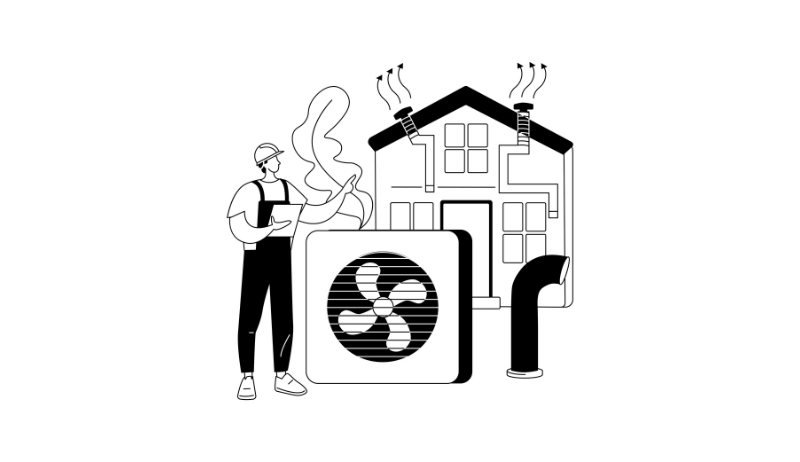If you’re dealing with cold air coming through your exhaust fan or you’re simply looking for ways to make it more effective, you’re not alone. Exhaust fans are a great way to remove moisture, odors, and pollutants from the air, but they can also be prone to problems like air leaks and reduced efficiency over time. Luckily, there are straightforward ways to seal the gap and prevent cold air from entering, such as installing an exhaust fan seal on your exhaust fan.
In this article we’ll give you some tips for boosting your exhaust fan’s performance, such as cleaning the blades, upgrading to a higher CFM fan, and using it regularly.
So, let’s dive in and get your exhaust fan running smoothly and effectively!
The Importance of Sealing the Gap on Your Exhaust Fan

How To Make My Exhaust Fan More Effective
- Clean the fan blades and housing: Over time, dust and debris can build up on the fan blades and housing, reducing the fan’s effectiveness. Clean the blades and housing regularly to keep the fan running smoothly and ensure it is operating at maximum efficiency.
- Upgrade to a higher CFM fan: CFM (cubic feet per minute) is a measure of the amount of air a fan can move. If your exhaust fan is not moving enough air, consider upgrading to a higher CFM fan. A higher CFM fan will be able to remove more moisture and odors from your home.
- Vent the fan to the outside: Make sure your exhaust fan is vented to the outside of your home, rather than just recirculating air back into the room. Venting to the outside will help to remove the moisture and odors from your home more effectively.
- Install an exhaust fan seal: A seal will help to ensure that the fan is operating at maximum efficiency, while also improving the overall air quality in your home.
How to Seal the Gap on Your Exhaust Fan
Disclaimer – The information provided in this article is for educational purposes only and should not be taken as professional advice. It is recommended to consult with a qualified contractor or electrician and follow all safety precautions and manufacturer’s instructions when making any repairs or upgrades to your exhaust fan. Sealing the gap on your exhaust fan is a simple process that can be done with a few basic tools and materials. Here are the steps to follow:
- Turn off the power to the exhaust fan by switching off the circuit breaker that controls it.
- Remove the cover or grille from the exhaust fan by unscrewing the screws that hold it in place.
- Inspect the gap around the fan to determine the best method of sealing it. In most cases, the gap can be sealed with caulking or foam weatherstripping.
- If you are using caulking, apply a small bead of caulking around the perimeter of the fan where it meets the ceiling or wall.
- If you are using foam weatherstripping, cut a piece of weatherstripping to the length of the gap around the fan. Peel off the backing and press the weatherstripping into place, making sure that it adheres to both the fan and the ceiling or wall.
- Replace the cover or grille on the exhaust fan and secure it with the screws.
- Turn the power back on to the exhaust fan and test it to ensure that it is working properly.

Best Way to Seal the Gap - Exhaust Fan Seals (Free under VEU Program)
Exhaust fan seals are an essential component of any ventilation system. They prevent air from escaping or entering through gaps around the fan housing, ensuring that the fan is working efficiently and effectively. Without a proper seal, an exhaust fan can be noisy, allow cold air into your home, or even cause a dangerous buildup of carbon monoxide.
Under the Victorian Energy Upgrades (VEU) program, free exhaust fan seals are available to eligible households in Victoria, Australia. The program is designed to reduce energy usage and greenhouse gas emissions by providing incentives for energy-efficient upgrades in homes and businesses.
By sealing the gap on your exhaust fan, you can prevent cold air from entering and reduce the amount of energy required to heat your home. To determine your eligibility for the program and to apply for free exhaust fan seals, get in touch with us TODAY! Fill out this form and we will reach out to you.
How Do I Stop Cold Air from Coming Through My Exhaust Fan?
If you’re experiencing cold air coming through your exhaust fan, there are a few potential causes and solutions to this issue. Here are some steps you can take to stop cold air from coming through your exhaust fan:
Check the damper: Many exhaust fans come equipped with a damper that helps to prevent air from flowing back into the home when the fan is not in use. If the damper is not working correctly or is stuck in an open position, cold air may be able to flow back through the exhaust fan. Check the damper to ensure it is functioning correctly and not allowing air to flow through when it should be closed.
Insulate the ductwork: If your exhaust fan ductwork runs through an unheated area, such as an attic or crawlspace, the cold air outside may be able to seep through the ductwork and enter your home. In this case, insulating the ductwork can help to prevent cold air from coming through the exhaust fan.
Seal any gaps around the fan: Check for any gaps around the fan, including between the fan housing and the ceiling or wall. Use caulking or foam weatherstripping to seal any gaps and prevent cold air from entering. Or simply use an exhaust fan seal.







